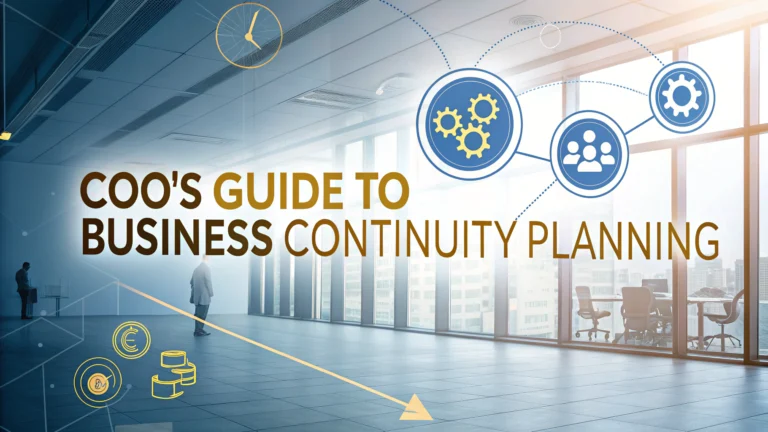Business continuity planning (BCP) helps organizations maintain essential operations during disruptions, from natural disasters to cyber attacks.
As Chief Operating Officer, your role in developing and implementing an effective BCP strategy directly impacts your organization’s resilience and recovery capabilities.
This guide outlines the key components of BCP, practical implementation steps, and best practices for COOs to protect their organizations.
Key Components of Business Continuity Planning
- Risk Assessment and Business Impact Analysis
- Recovery Strategies Development
- Plan Documentation and Testing
- Employee Training and Communication
- Regular Updates and Maintenance
Risk Assessment Steps
Start by identifying potential threats specific to your industry, location, and operations.
Evaluate the likelihood and potential impact of each identified risk.
- Natural disasters (earthquakes, floods, hurricanes)
- Technology failures (system outages, data breaches)
- Supply chain disruptions
- Public health emergencies
- Human-caused incidents (cyber attacks, theft)
Business Impact Analysis
Determine which business functions are most critical to operations.
| Priority Level | Recovery Time Objective | Example Functions |
|---|---|---|
| Critical | 0-4 hours | IT systems, emergency response |
| High | 24 hours | Customer service, core operations |
| Medium | 72 hours | Administrative functions |
Recovery Strategy Development
Create specific procedures for each critical business function.
- Alternative work locations and remote work capabilities
- Data backup and recovery systems
- Emergency communication protocols
- Supply chain alternatives
- Financial reserves and insurance coverage
Implementation and Testing
Schedule regular testing exercises to evaluate plan effectiveness.
- Tabletop exercises (quarterly)
- Full-scale simulations (annually)
- System recovery tests
- Staff training sessions
Communication Planning
Establish clear communication channels for different scenarios.
- Emergency contact lists
- Stakeholder notification procedures
- Media response protocols
- Customer communication templates
Resource Management
Maintain an updated inventory of essential resources.
- Emergency supplies
- Backup equipment
- Alternative vendor contacts
- Staff cross-training documentation
Plan Maintenance and Updates
Review and update your BCP at least annually or after significant organizational changes.
- Document revision history
- Update contact information
- Incorporate lessons learned from tests
- Adjust for new risks or business changes
Next Steps for COOs
Schedule a BCP review meeting with key stakeholders to assess your current plan.
Contact professional organizations like the Disaster Recovery Institute International (DRI) at +1-866-542-3744 for certification and training resources.
Consider engaging business continuity consultants for specialized guidance and plan development.
Leadership and Team Engagement
Build a dedicated business continuity team with clear roles and responsibilities.
- Assign department representatives
- Define decision-making authority
- Establish regular meeting schedules
- Create accountability measures
Technology Integration
Leverage technology solutions to enhance BCP effectiveness.
- Cloud-based document storage
- Emergency notification systems
- Remote collaboration tools
- Automated backup solutions
Regulatory Compliance
Ensure your BCP meets industry-specific regulatory requirements.
- Industry standards documentation
- Compliance audit schedules
- Regular reporting procedures
- Documentation retention policies
Vendor and Partner Management
Integrate key suppliers and partners into your continuity planning.
- Vendor assessment criteria
- Service level agreements
- Joint testing exercises
- Alternative supplier identification
Securing Organizational Resilience
Effective business continuity planning requires ongoing commitment and resources from leadership. As COO, your role in championing these efforts is crucial for organizational sustainability.
- Maintain executive support and engagement
- Allocate sufficient budget and resources
- Foster a culture of preparedness
- Monitor and measure program effectiveness
Remember that BCP is not a one-time project but an evolving program that grows with your organization. Regular review, testing, and updates ensure your organization remains prepared for whatever challenges lie ahead.
FAQs
- What is the primary role of a COO in business continuity planning?
A COO is responsible for developing, implementing, and maintaining the organization’s business continuity strategy, ensuring operational resilience, and coordinating with department heads to establish recovery procedures. - How often should a business continuity plan be reviewed and updated?
Business continuity plans should be reviewed at least annually, with updates made whenever significant changes occur in operations, technology, personnel, or business processes. - What are the key components of a comprehensive business continuity plan?
Key components include risk assessment, business impact analysis, recovery strategies, emergency response procedures, crisis communication protocols, and testing/training programs. - How should a COO prioritize critical business functions during a disruption?
Functions should be prioritized based on their impact on revenue, customer service, regulatory compliance, and operational dependencies, using Recovery Time Objectives (RTO) and Recovery Point Objectives (RPO). - What role does technology play in business continuity planning?
Technology supports data backup, system redundancy, remote work capabilities, automated failover systems, and communication platforms essential for maintaining operations during disruptions. - How should a COO approach supply chain resilience in continuity planning?
COOs should implement supplier diversification, maintain alternative vendor relationships, establish backup logistics routes, and create inventory buffers to mitigate supply chain disruptions. - What are the essential testing methods for business continuity plans?
Essential testing methods include tabletop exercises, functional drills, full-scale simulations, and technical testing of backup systems and recovery procedures. - How should a COO manage stakeholder communications during a crisis?
COOs should establish clear communication channels, develop pre-approved message templates, maintain updated contact lists, and ensure regular updates to employees, customers, suppliers, and regulators. - What regulatory requirements should COOs consider in continuity planning?
COOs must ensure compliance with industry-specific regulations, data protection laws, security standards, and reporting requirements while maintaining documentation of plan testing and updates. - How can a COO ensure adequate resource allocation for continuity planning?
COOs should secure executive support, establish dedicated budgets, assign responsibility to key personnel, and demonstrate ROI through risk mitigation and operational resilience.
